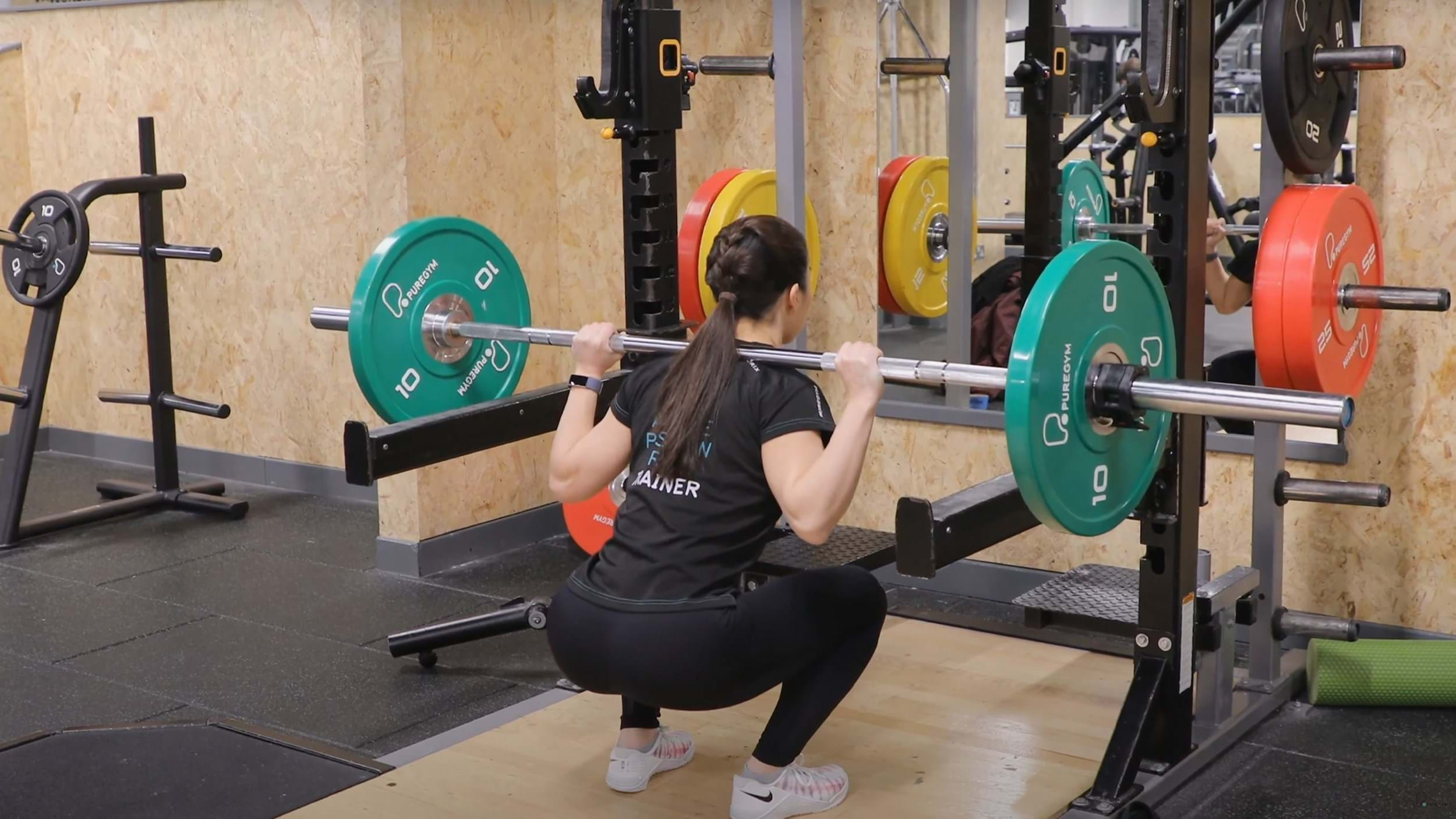Barbell Back Squats
What Is A Barbell Back Squat?

The barbell back squat is one of the most popular squat variations and makes up one of the three main powerlifting lifts. Using a barbell allows the squat to be loaded heavy, and also means you can increase the weight by smaller amounts to progress. It's a great exercise for building both strength and hypertrophy, and a staple in many workouts.
Before attempting the barbell squat, we'd recommend trying variations like the goblet squat and dumbbell squat and ensuring you're feeling confident and able to keep good form. Start light and once you're using to the movement with a barbell, you can start adding weight. Going too heavy can affect form and prevent the correct muscles being worked, as well as risk injury.
The barbell squat is a challenging movement. While most of the emphasis is placed on the lower body (particularly the glutes, hamstrings, and quads), it's a full body exercise with the core working to stabilise the spine throughout the movement, and the back muscles working to keep the barbell in position.
Check out some other squat variations: front squats, sumo squats, goblet squats, split squats, hack squats
Commonly Asked Questions On Barbell Squats
Barbell back squats are first and foremost a lower body exercise, with the glutes, hamstrings, quads, and lower back muscles working to drive the movement. The upper back and core are also involved, and the exercise will work to improve your mobility, stability, and coordination.
Back squats are not bad for you when performed correctly. Due to the bar placement and the potential load that can be lifted, back squats can cause injury if incorrect form is pursued. Furthermore, if you have an injury or joint weakness it may be best to discuss with a professional as to whether back squats are suitable for you.
While back squats are an effective exercise, they are by no means necessary, and you’ll be able to reach your fitness goals without them. If you don’t enjoy back squats or struggle to make the movement work, you can replace them with another squat variation or other lower body exercises.
Barbell Back Squat Tips
Bar placement and bar path are important factors in a barbell back squat and are often overlooked.
The bar can sit in either a high bar or low bar positioning. The high bar squat rests the barbell on the traps just above the shoulder blades, while the lower back squat rests lower down the back, on the back of the shoulders. Most people find they can lift more load with a low bar squat is it requires less range of motion, but we recommend trying both to see which works best for you.
The bar path refers to the line the bar takes from top to bottom. This should be a straight path which tracks over the mid foot throughout the whole squat. Engaging your back will help to keep the bar path straight, however ankle mobility can have a big impact on bar path (as well as squat depth). If you have limited ankle mobility you may find your chest collapsing during the movement, or simply being unable to squat past parallel. Elevating your heels with plates or weightlifting shoes creates an artificial ankle mobility and can aid the torso in remaining upright for a correct bar path. You may also want to work on your mobility so this elevation can be reduced over time.
How To Do A Barbell Back Squat
Choose a small, lighter barbell that you can lift over your head to position on your back. Alternatively, if squatting heavier weights, use an Olympic bar that is racked in a squat rack.
If using a squat rack, set the barbell so it sits just below your shoulders and place the safety pins just below where the barbell would rest at the bottom of your squat. You can test this by performing a bodyweight squat and pausing at the bottom of the movement.
To unrack the barbell, duck under the bar and stand so that the bar rests on your traps (high bar) or below your shoulders (low bar). Pull your shoulders back and grip the bar with both hands then extend your legs and stand tall to unrack the bar, then take three steps back.
Adopt your preferred squat stance. Some people prefer a wider stance while others prefer a narrow stance – different stances can suit different anatomies better. Once you have your foot position, externally rotate your feet so that your toes are pointing out slightly.
Brace your core and then begin to squat down by simultaneously pushing your hips back and bending your knees. As your knees bend, push them outwards to ensure they don’t cave in.
Squat down until your thighs are at least parallel to the floor, or deeper if preferred.
Reverse the movement by pushing through both of your feet. Rather than just pushing through your heels, think about pushing the ground away with the entirety of both feet.
Push up until you’re standing tall, keeping a soft bend in the knees. Slightly squeeze your glutes as you reach the top but avoid pushing your hips forward as this can place unnecessary pressure on the lower back.
If you’re not sure if any of the above exercises are suitable for you, please consult your doctor before you start it. Need guidance on how to perform the exercise? Ask a personal trainer at your gym.